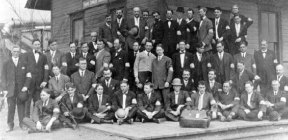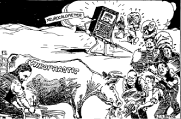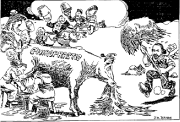Morris was more than the architect of the UCA. His defense strategy, commencing in the Morikubo case, had created a "philosophy of chiropractic" (i.e., a set of principles) that would become standard rhetoric within much of the profession.
...the erudite Tom Morris was the brains behind B.J. He had already developed the idea of chiropractic philosophy in his masterful courtroom presentation in La Crosse and had carefully coached his witnesses, including B.J. Palmer.
While B.J. Palmer built the PSC and grew the ranks of the profession, Morris carved out its legal niche. In the years following the Morikubo trial, the UCA became the leading mutual protective organization for DCs, outlasting and/or absorbing such rivals as the Minnesota-American Chiropractic Association, the International Chiropractic Association (no relation to today's ICA) and the National Chiropractic Protective Association (established by the leaders of the National College in Chicago). Members of the UCA paid an annual fee ($5 initially) plus such periodic "assessments" as legal demands required. As an increasing number of states authorized chiropractic, protection from civil suits (malpractice) and judgments came to occupy a growing share of the legal costs of the UCA. Paid-in-full members were advised to contact La Crosse as soon as they had any suspicion that charges or claims might be made against them. Palmer explained the process:
The old UCA did not...plead guilty. If one of its members were charged with mal-practice, it stipulated that the local Chiropractor secure a competent but reasonably-priced counsel. He was instructed by our National Counsel that he must not agree to or stipulate anything without our National Counsel's consent and knowledge. The member was, and is, instructed that the case would be tried in the courts on its merits. A date was set for trial. Our National Counsel spent time in his office preparing the trial. Then our National Counsel traveled from his home state, to that distant state. Medical and Chiropractic experts from within our ranks, and sometimes from without, were hired. These were transported to the scene of the trial - all this at association expense. The case was tried. It was fought thru sometimes several days. Witnesses were subpoenaed; they were paid, etc. In this way, the case would cost not less than $1,500.00, and sometimes as much as $5,000.00, and in one case $10,000.00 - all of which was paid by the Association. If convicted and judgment assessed, the Association would pay damages alone up to $5,000.00.But, the Chiropractor did not plead guilty to injuring a patient with Chiropractic; the Chiropractor did not admit publicly in open court, and therefore in the public press, that he was mal-practicing Chiropractic; or, mal-practicing medicine and surgery when practicing Chiropractic; thus the good, fair, and clean name of Chiropractic was preserved in its purity for posterity (Palmer, 1931).
The firm issued written directions (Morris & Hartwell, 1922) that UCA members were expected to distribute to their local attorneys, who in turn were expected to pave the way for the specialists from Wisconsin. Several classes of membership were created: for instance, for those practicing in "open" (unlicensed) jurisdictions vs. those where chiropractic was endorsed by statute, and where malpractice cases replaced criminal proceedings. The activities of the legal protective organization increasingly foreshadowed the operations of today's National Chiropractic Mutual Insurance Company. Morris and his team helped to demystify the legal process for UCA members by holding mock trials, as noted in The Chiropractor, the official publication of the PSC and UCA:
Very few boys in the field know how a trial is conducted, how the warrants are made, how complaints are filed or know what it is to be quizzed on cross-examination. To make all acquainted we propose to devote one entire afternoon to a mock trial. Fred Hartwell will be prosecutor and Tom Morris defender. The balance of the participants will be elected at the time. This will give all who attend an inside working knowledge of how the legal subjects are carried by The U.C.A.
When the UCA was summoned, one or more of the UCA legal staff (e.g., Tom Morris, Fred Hartwell, Frank Winter, Arthur T. Holmes, Otto Bosshard, Lawrence Brody) would arrive at the trial site, usually accompanied by one or more expert witnesses, such as B.J. Palmer, Lee W. Edwards, MD, DC of Omaha, National College president William C. Schulze, MD, DC and Alfred B. Hender, MD, DC, dean of the PSC. Palmer and Edwards reportedly testified in thousands of trials and brought with them reams of documents and propaganda. At a time in America before routine, widespread travel, when radio was still a novelty, the mere fact that a defendant chiropractor could summon out-of-state experts was impressive. Morris' status as a former state senator and former lieutenant governor also lent stature to the DC's case. And if a trial took place anywhere near Davenport, the troupe might well expand by dozens with the addition of PSC students. Such an "army" made an impression on jurors and townsfolk: chiropractic was substantial.

Arthur T. Holmes, circa 1927. (photo courtesy of Cleveland Chiropractic College of Kansas City, Library Archives)

Lawrence Brody, circa 1927. (photo courtesy of Cleveland Chiropractic College of Kansas City, Library Archives)
The prosecution of a chiropractor for unlicensed practice might also take on a carnival air, as B.J. described in his report of the trial of I.B. Hall, DC in Scott City, Kansas in 1911 (Metz, 1965, pp. 19-20). Morris was accompanied to the rural county seat by Palmer, Lee Edwards, and Alfred Walton of New York City, a graduate of the Harvard Medical School. The event drew inquiring minds from a 60 mile radius. Morris easily demolished the credibility of the local allopaths who had instigated the criminal action by demonstrating their greater concern for pecuniary reward and self-interest than for the public welfare. The patients called as witnesses for the prosecution were reluctant to speak ill of their chiropractor, but readily offered testimonial evidence of the benefit they had derived from chiropractic care following failure of medical treatment. The polish and charisma of the expert witnesses added to the flavor of the spectacle. Palmer reported:
The jury at Scott City knew what chiropractic was, decided they wanted to continue to have it, said so with their verdict, and that settled that. The jury knew it was not medicine, so why should they convict the chiropractor of practicing medicine or surgery, or be registered as doing so. The jury was out only one half hour in coming to their decision, "not guilty." (B.J. Palmer, quoted in Metz, 1965, pp. 20-4).

Students and faculty of the Palmer School, circa March, 1910, who traveled to Montezuma, Iowa to attend the trial of "State of Iowa vs. Corwin," a chiropractor; the two men standing center, front are the local sheriff and the defendant; C. Sterling Cooley, DC, is fourth and B.J. Palmer is eighth from right in rear row; note "PSC" armbands (photo courtesy of Texas Chiropractic College)
The UCA faced a new rival for its services beginning in 1922, when the broad-scope-tolerant American Chiropractic Association (ACA) was established by UCA dissidents and others (Keating, 1996). Not to be confused with the earlier ACAs formed in Minnesota and Oklahoma, this third ACA was led from 1923-1929 by attorney-chiropractor Frank R. Margetts, a former faculty member of the National College of Chiropractic. Although it also offered legal protective services through arrangement with an insurance company, the ACA's primary missions were professional improvement and a more democratic process. It provided an alternative to what was increasingly seen as the "rule or ruin policy of the Palmer-UCA combination" (Lee, 1927). Palmer and the UCA had commenced a "house cleaning" campaign in the early 1920s, intended to purge "mixer" chiropractors from the ranks of state associations. Outraged by Palmer's arrogance, many UCA members resigned their memberships, and many joined the ranks of the ACA. Intra professional hostility grew more intense in 1924 when Palmer introduced his neurocalometer (NCM) and branded as unethical all who refused to lease his subluxation-detection device. Now B.J. encountered dissension not only from without (e.g., ACA, disaffected mixers), but from within the ranks of his own previously faithful followers (Keating, 1997).
Parting of the Ways
The NCM and B.J.'s program amounted to the proverbial last straw for many in the profession, including Tom Morris. Palmer derided mixers, claiming that they enjoyed the "fruits of chiropractic" (Palmer, 1931) without contributing to its nurturance. Now it was B.J.'s turn to "milk" the chiropractic cow, and the NCM was the means to that end. But the 10-year, $2,200 lease for the device smacked of gouging, and many DCs were disgusted. Palmer looked vainly to Morris for support:
...Dr. Palmer made it clear that the situation was desperate and that Morris alone could extricate him.Aware that refusal meant the severance of friendship, Morris nevertheless declared that their policy faced the crucial test. As they had always upheld the right of the sick, so must they uphold the right of the chiropractor, for the cause was common to both. A neurocalometer, which Tom Morris heard could be made for thirty dollars, could not be forced upon the profession at a figure so exorbitant as to be commensurate with an interest of 7,000 percent.
This private appeal by Dr. Palmer occurred at the Chicago convention of 1925. Morris addressed the delegates, enunciated again the principles which condemned the nerve-tester, and tendered his resignation as chief counsel of the association. Dr. Palmer followed with his resignation as secretary.
Stormy scenes occurred. The convention was asked to decide which of the two leaders should be retained. Dr. Heinrich Derringer of New York, one of the most influential chiropractors of the country, flayed Morris in an indignant speech. Three years later on his deathbed, it is said, he called for Morris to come and forgive him. The outcome of the vote on the convention floor was that Morris was reinstated. The office of the association was moved from Palmer School to the suite occupied by the attorney in La Crosse, Wisconsin (Turner, 1931, pp. 179-80).
In the closing years of Morris' life he functioned as the de facto leader of the UCA, while Palmer ran the CHB. The attorney was assisted in his added role as UCA business manager by his sons Douglas R. Morris, DC of Indianapolis and Thomas Morris, Jr., LLB of Los Angeles. Morris cautiously moved the old protective society into merger discussions with the ACA (Morris, 1927b), but died in 1928, two years before the creation of the National Chiropractic Association (NCA; forerunner of today's ACA). Palmer eulogized his long-time partner on the cover page of his personal newsletter, the Fountain Head News; Morris, he wrote, was the "best friend chiropractic ever had" (Rehm, 1998) and "one of the very few real, genuine friends that I have ever had...For twenty years we were as brothers" (Palmer, 1928). The attorney from Wisconsin, he suggested, had "never lost sight of the great objective - the right of the sick to get well!"
The attorney's passing was noted in newspapers throughout the nation. The Chicago Tribune observed that "Twenty-five years ago he was rated as one of the triumvirate with LaFollette which ran Republican politics" in Wisconsin. In Wisconsin, "a day of mourning was declared for his funeral" (Rehm, 1998). But in decades to come, the memory of the "Defender of Chiropractic" would fade, a victim of the profession's historical ennui.

From the Fountain Head News for November 8, 1924. Above: Palmer suggests that he's been working at the feeding end of the cow (chiropractic), and wonders why he can't have a glass of milk once in a while. Below: the neurocalometer forces mixers to give something back to the cow while BJ draws a dividend.
Tom Morris saved the bacon for chiropractic at a critical juncture in the profession's evolution, and continued his campaign to protect and defend the UCA membership for more than 20 years. His La Crosse legal team handled some 3,300 of the estimated 15,000 prosecutions of chiropractors in the profession's first 30 years (Turner, 1931, pp. 178, 294) and successfully resolved a reputed 80% of them. Moreover, he left behind a legal tradition, not only in terms of the case law he helped to create, but also in terms of his law firm and its successors. Junior partner Arthur T. Holmes succeeded him as chief legal counsel for the UCA, and served for many decades as counsel to the NCA and the National Chiropractic Mutual Insurance Company (NCMIC). Holmes' successors in La Crosse (attorneys Robert D. Johns and Daniel T. Flaherty) continued in service as general counsel to the NCMIC through 1980. Indeed, today's NCMIC may be construed as a continuation of the mutual, legal protection services established by Morris and the UCA.
Morris' death may be seen as one of the markers for the transition into the "middle ages" of the chiropractic profession. With the birth of the CHB (1926) and the NCA (1930), new lines were drawn that would shape the intra-professional struggles among chiropractors for decades to come. Meanwhile, Tom Morris the man would be forgotten, but the principles he stood for would not. He will always occupy a unique niche in the history of chiropractic.

Attorney Robert D. Johns, circa 1945.
References:
- Address of welcome delivered by Prof. Willard Colman, La Crosse, Wis., At the opening and first meeting of the U.C.A. The Chiropractor 1906 (Oct); 2(11):30-2.
- An association of schools and colleges. Fountain Head News 1917 [A.C. 23] (Sept 22); 7(1-2):1-2.
- An attorney's congratulations. UCA News 1927 (Feb 10); 2(6):7.
- Annual meeting of Board of Directors of the Universal Chiropractors' Association, Davenport, Iowa, 26-27 August 1918 (Palmer College Archives).
- Brown U. Defense worth having. The Chiropractor 1911 (Jan);7(1):28-9.
- Bulletin of the American Chiropractic Association 1927 (Nov); 4(6):21.
- Bulletin of the American Chiropractic Association 1928 (Oct); 5(5):15.
- Edwards LW. How far we have come? A pioneer looks back through the years. The Chiropractic Journal (NCA) 1938 (Nov); 7(11):11-2.
- Gilkey GR. The First Seventy Years: a History of the University of Wisconsin-La Crosse, 1909-1979. La Crosse WI: University of Wisconsin-La Crosse Foundation, Inc., 1981.
- Gregory, John G. (Ed.): West Central Wisconsin: a History. Indianapolis: S.J. Clarke Publishing Co., Inc., 1933; Vol. IV, pp. 411-5.
- Keating JC. Introducing the neurocalometer: a view from the Fountain Head. Journal of the Canadian Chiropractic Association 1991a (Sept); 35(3):165-78.
- Keating JC. The short life and enduring influence of the American Chiropractic Association, 1922-1930. Chiropractic History 1996 (June); 16(1):50-64.
- Keating JC. B.J. of Davenport: the Early Years of Chiropractic. Davenport IA: Association for the History of Chiropractic, 1997.
- Keating JC, Rehm WS. The origins and early history of the National Chiropractic Association. Journal of the Canadian Chiropractic Association 1993 (Mar);37(1): 27-51.
- Lee LE. Force the issue. Bulletin of the American Chiropractic Association 1927 (Mar);4(2):11-2.
- Lerner C. Report on the History of Chiropractic. 1954, unpublished manuscript in 8 volumes (Lyndon E. Lee Papers, Palmer College Archives).
- Mawhiney RB. Chiropractic in Wisconsin, 1900-1950. Madison WI: Wisconsin Chiropractic Association, 1984, pp. 34-6.
- Metz M. Fifty Years of Chiropractic Recognized in Kansas. Abilene KS: Shadinger-Wilson Inc., 1965.
- Morikubo S. Letter to D.D. Palmer. The Chiropractor 1906a (Jan);2(2):13.
- Morris T. Fountain Head News 1916 (Jan 22);5(2):6.
- Morris T. Amalgamation. UCA News 1927b (Feb 10);2(6):3.
- Morris T, Hartwell FH. Instructions for local attorneys for use in cases against members of the UCA, 20 October 1922 (Cleveland papers, Cleveland Chiropractic College of Kansas City).
- Palmer BJ. Fountain Head News 1916a (Jan 22);5(2):3.
- Palmer BJ. Fountain Head News 1916b [A.C. 22] (Sept 9);6(1):2.
- Palmer BJ. Tom is dead. Fountain Head News 1928 [A.C. 32] (Nov 10);16(7):1.
- Palmer BJ. The ACA-UCA union - what does it actually mean? Fountain Head News 1931 [A.C. 35] (Feb);18(3):5-11.
- Rehm WS. Legally defensible: chiropractic in the courtroom and after, 1907. Chiropractic History 1986;6:50-5.
- Rehm WS. Remembering Tom Morris. Journal of Chiropractic Humanities 1998; 8:67-70.
- Smith OG, Langworthy SM, Paxson M. Modernized Chiropractic. Cedar Rapids IA: Laurance Press, 1906.
- Turner C. The Rise of Chiropractic. Los Angeles: Powell Publishing Company, 1931.
If your interest in chirohistory has been stimulated, then consider joining the Association for the History of Chiropractic (AHC). Founded at Spears Hospital in Denver in 1980, the AHC is a non-profit, membership organization whose goal is the discovery, dissemination and preservation of the saga of chiropractic. The AHC held its first annual Conference on Chiropractic History at the Smithsonian Institute in Washington, D.C. in 1980, and has held similar conferences each year since at various chiropractic colleges. The AHC's 2000 Conference on Chiropractic History will be held in San Antonio, Texas in conjunction with the annual meeting of the Association of Chiropractic Colleges in March. Details about the upcoming conference can be obtained by contacting the AHC:
Glenda Wiese, M.A.,
Executive Director
Association for the History of Chiropractic
1000 Brady Street,
Davenport IA 52803
The AHC publishes a scholarly journal, Chiropractic History, in which chiropractors and interested observers contribute their expertise to telling and interpreting the rich lore of the profession. The journal, which is indexed in the National Library of Medicine's Bibliography of the History of Medicine, is published twice per year. Chiropractic History is distributed to all members of the AHC as a membership benefit. Membership in the AHC can be obtained by sending your name, address and check for $50 ($20/year for students) to the AHC's executive director:(same contact information as above).
Click here for previous articles by Joseph Keating Jr., PhD.







